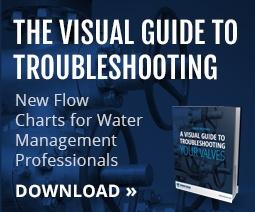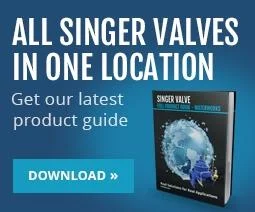
For basic pressure management or more advanced modulating pressure management, water suppliers create a network of District Metered Areas (DMA’s) or smaller, more manageable pressure management zones. The DMA or pressure zone gives the ability to measure flow and control pressure, when a Pressure Reducing Valve (PRV) or Automatic Control Valve (ACV) is installed at the takeoff of the DMA from the Main Distribution line. Here are the top 10 considerations when choosing the correct valves to optimize the functionality and performance of the DMA.
 1. Correct Sizing of the Pressure Reducing Valve
1. Correct Sizing of the Pressure Reducing Valve
One of the most common mistakes made in sizing ACV’s or PRV’s in District Metered Areas, is to the valve match the pipe size. However the most important factor in size selection is to review the “Maximum Flow Rate”. Manufacturers of PRV’s provide sizing charts and programs to determine the right PRV for the maximum flow rate. If a PRV is oversized, the valve can be very unstable at low flows as many PRV manufacturers suggest their valves are most stable when operating in the 20 - 80% stroke range. If the valve has been oversized then it may only be slightly open at maximum flow, resulting in hunting (instability) and seat chatter. This typically results in more maintenance and service issues.
An engineer should evaluate current maximum flow and also account for future expansion and future maximum flows. Not only should potable water use be considered but also fire flow requirements.
Many manufacturers offer a reduced port version of their ACV’s. While the flanges match the nominal pipe size, the seat area of the valve is designed to be one size smaller than the nominal pipe size. So you have a choice of a full port valve or reduced port valve. Never oversize your valves, always consider maximum flow as your primary determining factor.
 2. High Flow and Low Flow Capabilities
2. High Flow and Low Flow Capabilities
When selecting a control valve and particularly a PRV, it’s important to clearly understand the flow range. Many diaphragm valve manufacturers can be challenged to handle lower flow ranges as the valves can become very unstable at low flows resulting in seat chatter, hunting and even minor surges into the downstream piping. This can be detrimental to the valve and downstream piping resulting in additional maintenance or reduced life. In most water utility systems it’s normal to have a maximum flow rate (often daytime, breakfast/dinner) and you have extreme low flow periods (middle of the night).
Because of changing flow rates many engineers will specify a main PRV with a smaller PRV located on the bypass. When demand is large, the flow is handled by the large PRV and when the flow is low it’s handled by the smaller PRV. This system works well; only it increases costs and size of the chamber required for the additional bypass valve.
Another method of handling lower flows is with a Single Rolling Diaphragm (SRD) that can handle the full range of flows from extremely low to high, thus eliminating the need for a smaller bypass valve. You may still choose to include one for servicing your main control valve.
 3. Ability to Add Features to Ensure Additional Benefits
3. Ability to Add Features to Ensure Additional Benefits
Having the ability to add additional features maximizes your valve potential. Most top serviceable brands allow you to add features that can interface with your stem to show position indication or limit switches if electronic. Valves that use SCADA may require an electronic position indicator or limit switch that can be added initially or retrofitted.
Ensuring that the valve has additional threaded body taps on both sides of the PRV, allows you to move the pilot system to the alternate side if you do not have room to work in the chamber or to add additional features, like electronics, sensors or gages in the future. It is always recommended to have pressure gages installed, typically 1 or 2 pipe diameters away from the valve for best measurement.
4. Top Serviceable
 Most ACV’s are top serviceable where the stem is 90 degrees to the horizontal. This allows both the bonnet and the inner valve to be lifted vertically for quick and easy maintenance and avoid removing the valve completely. Y style PRV’s cannot be removed by lifting straight up, making the re-aligning of the inner valve components and bonnet for re-assembly difficult and time consuming.
Most ACV’s are top serviceable where the stem is 90 degrees to the horizontal. This allows both the bonnet and the inner valve to be lifted vertically for quick and easy maintenance and avoid removing the valve completely. Y style PRV’s cannot be removed by lifting straight up, making the re-aligning of the inner valve components and bonnet for re-assembly difficult and time consuming.
5. Specify Key Component Materials
 As ACV materials vary it’s important to specify superior materials for the key components in order to maximize the life of your valve and minimize the maintenance. A few key components include:
As ACV materials vary it’s important to specify superior materials for the key components in order to maximize the life of your valve and minimize the maintenance. A few key components include:
- A 316 stainless steel seat is superior on wetted components and almost twice as strong as 304 stainless steel.
- Use 18/8 stainless steel fasteners that won’t rust.
- Specify Heat Fusion Epoxy Coatings for inside and outside the valve for resiliency.
- Specify Ductile Iron on the main valve and bonnets as it stretches in colder climates and earthquake regions.
6. Allow Sufficient Space in Chamber for Maintenance
You need sufficient room on the sides of the chamber where the pilot system is located for the operator to turn on and off the pilot isolation valves, flush the strainer and release air from the bonnet. Ensure adequate chamber height to allow an operator to lift off the bonnet and inner valve assembly for maintenance. Consider lifting eyes or sufficient apparatus on the ceiling to assist in lifting bonnets and inner valves within the chamber. Hatches should be designed to accommodate the removal of any equipment.
7. Getting Air Out
The control chamber requires water, not air and therefore when air enters it can cause instability and varying downstream pressures as you are losing control of the desired pressure settings and potentially introducing surges into the piping system downstream.
Air enters a system for a variety of reasons including pipe bursts and lack of constant water pressure. An air release valve upstream of the ACV and a combination air vacuum valve on the downstream side of the ACV will let air out of the system. Most ACV’s have a plug, which can be slightly unthreaded to purge the air or a position indicator with a small bleed valve on top, which can be manually opened. With either of these devices you simply open them slightly until the air or milky colored water is discharged, then retighten or close.
In a water system that is not pressurized 24/7, air can enter above the diaphragm each time the system is de-pressurized. You will then need to have an operator out relieving air each time this occurs (perhaps daily) or get a small air release valve on top of the ACV bonnet to purge air automatically.
 8. Keep the Pilot System Strainer Clean
8. Keep the Pilot System Strainer Clean
All ACV’s should have a strainer at the inlet to the ACV pilot system to prevent debris from plugging its components and causing an ACV failure. If the pilot system is exposed to debris, your ACV may fail fully open or fully closed. If your ACV goes fully open in the case of a PRV, you will have overpressures downstream and could cause pipe bursts, increased leakage rates or water loss. If the debris plugging the pilot system is on the outlet side of the control chamber, the valve could fail fully closed, which would be devastating during a fire. Strainers must be kept clean and serviced periodically which varies based on the water quality in your system.
Plugged strainers are usually the number one failure on ACV’s so keep your strainers clean.
9. Ensure You Have an Upstream Line Strainer
 It is important to have a strainer located upstream of an ACV or PRV. ACV’s will usually have a bottom guide assembly and without a strainer, all debris will work its way into the bottom guide located in the valve. This interferes with the seat area causing the valve not to close or control pressure properly. On new construction it is not uncommon to find wood, rocks, boots, even animals wedged in a valve without a strainer installed upstream.
It is important to have a strainer located upstream of an ACV or PRV. ACV’s will usually have a bottom guide assembly and without a strainer, all debris will work its way into the bottom guide located in the valve. This interferes with the seat area causing the valve not to close or control pressure properly. On new construction it is not uncommon to find wood, rocks, boots, even animals wedged in a valve without a strainer installed upstream.
A strainer should include some form of blow down port so that you can open and flush smaller debris out of the strainer without having to disassemble the entire strainer. Z style strainers are good as the short lay-length and the 316 stainless steel Z screen maximizes flow and minimizes turbulence.
10. Isolation Valves and Bypass Lines
 Isolation valves are extremely important and should be located upstream and downstream of the ACV. Without isolations valves you cannot service an ACV unless you drain the entire pipe line which could take days in some cases. Always make sure the pressure is relieved and the isolation valves are closed before starting to disassemble the ACV. It is recommended that a bypass line is installed around the main ACV to isolate and work on the main ACV in off-peak periods but still get water to customers while doing this.
Isolation valves are extremely important and should be located upstream and downstream of the ACV. Without isolations valves you cannot service an ACV unless you drain the entire pipe line which could take days in some cases. Always make sure the pressure is relieved and the isolation valves are closed before starting to disassemble the ACV. It is recommended that a bypass line is installed around the main ACV to isolate and work on the main ACV in off-peak periods but still get water to customers while doing this.








